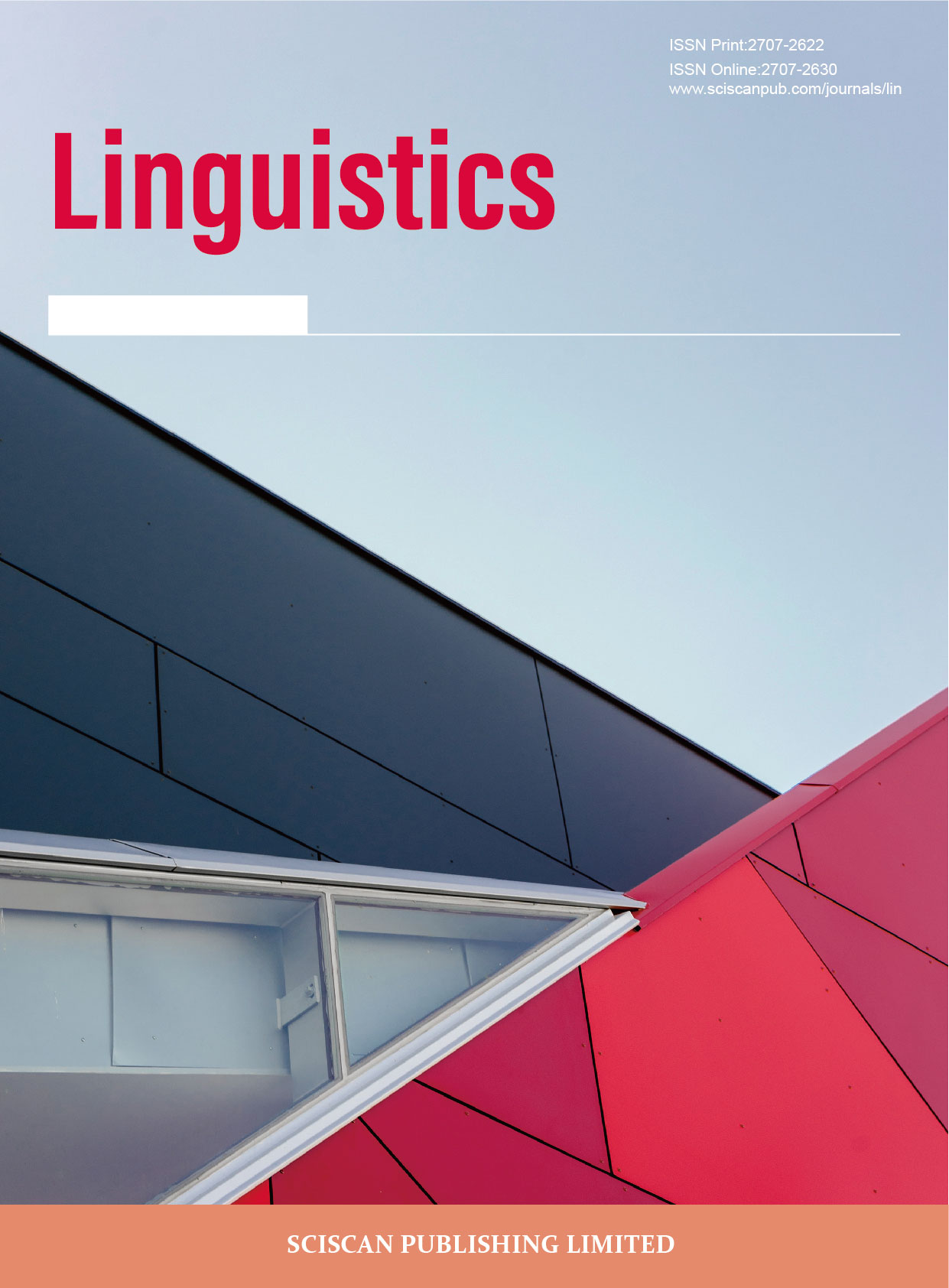认知识解视角下辜鸿铭《论语》英译研究
The Cognitive Construal of Ku Hung-ming’s Translation in The Discourses and Sayings of Confucius
- Authors: 张闽渝 冉诗洋
-
Information:
重庆邮电大学,重庆
-
Keywords:
Cognitive construal; The Discourses and sayings of Confucius; Ku Hung-ming认知识解理论; 《论语》; 辜鸿铭
- Abstract: Cognitive construal is one of the core concepts of cognitive grammar. It can explain why people have different expression forms when they treat the same event, which provides a theoretical basis for the interpretation and analysis of the phenomenon of the gap between the translation text and the original text. With the guidance of the cognitive construal theory, this paper analyzes The Discourses and sayings of Confucius translated by Ku Hung-ming from the four dimensions of specificity, scope and background, salience or prominence, and perspective, discusses the reasons of the forming of Ku’s version, and discovers the influence of this kind of construal on Ku’s translation process and the formation of The Discourses and sayings of Confucius. 认知识解作为认知语法的核心概念之一,能解释为什么人们在对待同一事件时会存在多种不同的语言表达形式,这可以为解释和分析翻译中译文与原文存在的差距提供理论依据。本文基于认知识解理论,从突显、辖域—背景、详略度、视角四个维度,采用英汉对比、文献考据等方法分析辜鸿铭的《论语》英译情况及其背后原因。从认知识解的四个维度可以解释辜译《论语》和原文的差距,发现译者在翻译之初将译文视为普及刊物,翻译时详略得当,注重突显原文思想文化;同时站在弘扬中国优秀传统文化的角度构建译本;原文与译文出现文化背景空缺时,译者调动原文背景,构建与原文相关的辖域,便于读者理解原文。
- DOI: https://doi.org/10.35534/lin.0401007
- Cite: 张闽渝,冉诗洋.认知识解视角下辜鸿铭《论语》英译研究[J].语言学,2022,4(1):61-70.
1 引言
《论语》是最能代表中国儒家文化的经典作品之一,涉及中国政治、教育、文学、哲学等多方面中国传统文化,集中体现了孔子的政治、审美、道德伦理等思想价值。因其重要的文化地位,不少国内外译者对《论语》进行过翻译,辜鸿铭(Ku Hung-ming)就是英译《论语》杰出代表之一。
学术界对辜鸿铭英译《论语》的研究较为丰富,研究主要集中在五个领域:《论语》英译的总体性研究、单一译本的鉴赏研究、多译本的比较研究、对《论语》核心概念的英译分析,以及《论语》译本的翻译技法分析[1]。但这些研究的研究对象仅局限于原文文本与译文文本,鲜有对译者翻译过程进行研究,目前仅有“认知识解理论视角下《论语》文化意象的英译探析”[2]一文从译者认知识解的角度探讨了《论语》中文化意象的翻译,并构建了翻译的三种认知原则:最佳关联、认知等效和认知增量,其研究对象仅限于文化意象,没有对具体的文本内容进行分析。因此本文基于兰盖克(Ronald W Langacker)的认知识解理论,依据王寅总结的认知识解四要素,从突显、辖域—背景、视角、详略度四个维度分析辜鸿铭英译的《论语》,探究译者在翻译选材、翻译目的和翻译策略上的取向,并结合具体的翻译文本进行双语对比分析,解释辜译《论语》译文和原文的异同。
2 认知识解概念介绍
认知识解最早由语言学家兰盖克提出,是认知语法的重要内容。兰盖克[3]认为,要识解某一事件,重要的不仅是表达出与之对应的概念内容,如何解释这些内容也同样重要。对于这种解释能力,人与人之间各不相同。之所以会出现不同,是因为在观看同一场景时,我们看到的内容取决于我们如何观察它,我们选择看什么,我们最关注哪些元素,以及我们从哪个角度看待。兰盖克将以上这些因素概括为识解五要素,即详略度(specificity)、辖域(scope)、背景(background)、视角(perspective)和突显(salience or prominence)。王寅[4]认为在兰盖克的识解五要素中,最核心的思想是“突显”,突显的内容不同是因为作者的视角存在差异,与突显相对的是不被突显,即“背景”和“辖域”;再者,突显既可以是针对大概内容粗略地描写也可以是着手细节详细刻画,这就有了“详略度”。因此,原本的背景、辖域可归纳为同一级别要素,认知识解五要素即可总结为四要素:突显、辖域—背景、视角、详略度。
翻译过程就是认知识解的过程,它包括对目标语和源语进行认知识解。在这两个过程中,译者由于受自身认知背景的影响,会“创造性”地模仿、再现源语文本,这就是王寅[5]所说的翻译一方面传递了原作者的信息,另一方面也不可避免地烙上了译者的立场和观点。
3 认知识解视角下辜鸿铭《论语》英译分析
根据王寅的认知识解四要素,以及四种要素的重要性和逻辑关系,可以对辜鸿铭英译《论语》从突显、辖域—背景、视角、详略度四个维度进行分析。
3.1 辜鸿铭英译《论语》中的突显
在兰盖克[6]看来,突显就是人们所拥有的聚焦能力,被聚焦的点被称为显景,与之相对的是背衬,显景/背衬格局构成了突显。在语言学里,因聚焦点的不同所形成的突显,表现为因动体/界标的不同而出现的语言结构不对称现象。描述一段关系时,参与者因得到不同程度的关注,个人需要基于某一认知参考点来确立自己的聚焦点,在大背景下突显想要表达的部分。因此,突显“直接反映了人们在主观上对某一事体感兴趣或最感兴趣的部分”[7]。
谈及辜鸿铭翻译《论语》的缘由,笔者查证到以下两点原因,第一,《辜鸿铭文集(下)》一书中《英译〈论语〉序》写道[8]:因为理雅各(James Legge)博士开始从事这项工作的时候,他的文学训练还很不足,完全缺乏评判能力和文学感知力。他自始至终都表明他只不过是个大汉学家,也就是说,只是一个对中国经书具有“死知识”的博学和权威而已;第二,为了消除当时西方对中国文化的误解和成见,以及改变无论是个人还是国际交往对于中国的心态。正是因为不满意理雅各的《论语》译本,想改变当时中国在国际上的形象,辜鸿铭才会开始提笔重译。辜鸿铭在翻译《论语》时注重如何让《论语》有效地在西方积极普遍传播,让西方人正确地了解饱含中国思想精髓的著作,译作在行文上更注重和突显传达中国传统思想和文化。为实现这一点,辜鸿铭采用不同翻译技巧,文本意义上突显中国传统思想与文化。
例如:有子曰:“其为人也孝弟,而好犯上者,鲜矣;不好犯上,而好作乱者,未之有也。”——《学而》
辜译版本:A disciple of Confucius remarked, “A man who is good son and a good citizen will seldom be found to be a man disposed to quarrel with those in authority over him; and men who are not disposed to quarrel with those in authority will never be found to disturb the peace and order of the State.”
原文“为人孝弟”“不好犯上”“好作乱者”都处于显景中,显景部分与中国文化息息相关。辜鸿铭翻译时突显了原文体现中国文化的部分,改变原文的倒装结构,译成连珠句,将“men who are not disposed to quarrel with those in authority”译为前半句的显景。译后半句时,这个当前话语空间被刷新,该部分成为了理解后半句“好作乱,未之有也”的背衬,译文与原文结构上的不对称促使了文本意义达到与原文一样的突显效果。
理雅各[9]版本:The philosopher Yew said, “They are few who,being filial and fraternal, are fond of offending against their superiors. There have been none, who, not liking to offend against their superiors, have been fond of stirring up confusion.”
理雅各翻译的版本[10]较辜译更为破碎,处理的分句成分较多。他将“鲜矣”“未之有也”放在显景的位置,将“为人孝弟”“不好犯上”“好作乱者”这几个具有中国文化特色的词处理成背衬,没有实现与原文本对等的突显效果。
3.2 辖域—背景与辜鸿铭英译《论语》
兰盖克认为理解文中词汇的过程涉及辖域—背景因素:词汇作为外界输入文本,直接访问读者所有的认知域,但只有有限的几个域可以在给定的情况下被激活,且是不同程度地激活,被高水平激活的就是辖域。通过语言表达,此辖域所对应的概念意义能以文字形式呈现出来。背景在概念意义上优先于辖域的出现,并在某种程度上促进了辖域的出现。从广义上说,如何用语言呈现高程度激活的辖域,需要说话者调用其认知基础。
《论语》当中涉及了许多中国传统文化,如孝道、为政之道、古时的教育理念等内容,这些内容在外国读者的认知背景中是不足或缺失的,为帮助读者构建认知域,译者会采用相应翻译手法,进而最高程度激活辖域,帮助读者理解译本。
辜鸿铭对儒家思想颇有研究,对此有其独到的见解。在《中国人的精神》一书中,辜鸿铭将儒家思想与西方的宗教作对比,从“宗教”的普遍意义上将儒家学说归类为一种宗教,从某种程度上和西方的宗教一样,都是人们的信仰,但二者本质上存在区别。辜鸿铭是这样解释的:他认为西方宗教与儒家学说存在超自然和现实之别。除此以外,西方字面意义上的宗教是要把人变成一个好人。儒家学说则远远不止这些。儒家学说教导人要成为良好的公民。简言之,西方人所称的宗教目的是想让人通过自身努力而转变为一个完美而理想的人,因而,要他成为一个圣徒、一个佛陀或者一个天使;而儒家学说则限定为,把人变成一个良民——像孝子和良民那样生活。换句话说,西方意义上的宗教说:“如果你想拥有信仰,你就必须是一个圣徒、一个佛、一个天使。”而儒家则说:“如果你遵守社会规范,孝敬父母,你就拥有信仰。[11]”在辜鸿铭看来,孔子的儒家思想在国家层面上树立了国家观念,由此可见辜鸿铭对儒家思想的高度赞扬和深度理解。辜鸿铭对儒家思想的内化和识解结合他本身对两国语言文化的储备,具备了译者对原语社会文化和背景知识的理解,并且能熟练运用语言文字将此传递给读者,让读者也能提前构建相关认知域。
例如:节用而爱人,使民以时。
译文:...and love the welfare of the people. He must employ the people at the proper time of the year.
原文“使”意为“使役”,孔子这句话是在提醒执政者使役百姓不要耽误农时。辜鸿铭的译文是要在合适的时间使役百姓。“使役百姓”是孔子时代百姓生活的背景信息,辜鸿铭为了让读者更好地获取这一信息,采用了注释的方法来描述当时的情况:In ancient China the people were lightly taxed, but were liable to force labor and conscription in times of war.
《八佾》篇第二章:三家者以《雍》彻。子曰:“‘相维辟公,天子穆穆’,奚取于三家之堂?”辜鸿铭在翻译“以《雍》彻”时处理为“...concluded the service in their chapel by chanting the hymn used only on occasions of Imperial worship”。孔子生活的时代,十分讲究礼数,孔子对这些礼数也颇为维护,当时天子有天子之礼,诸侯有诸侯之礼,唯有各守各的礼,宗法制的社会才可以安定。本章讲到孟孙氏、叔孙氏、季孙氏三家在祭祖完毕撤去祭品时,乐工唱的是《雍》这篇诗,这违背了当时的礼节,因此孔子十分愤怒。为了将孔子愤怒的缘由表达得更能为外国读者所接受,辜鸿铭介绍了天子祭祀时乐工才能唱《雍》这一文化背景。《论语》中涉及的背景文化信息还很多,像以上这样把背景文化补充出来的翻译措施,对于外国读者理解是非常有帮助的。
3.3 视角与辜鸿铭英译《论语》
兰盖克从时空地理角度出发,认为视角是人们观看事物时的角度,你所看到的部分与你占据的地理位置有关。与中国古诗“横看成岭侧成峰,远近高低各不同”有异曲同工之妙。在认知识解中,兰盖克认为视角主要包括视点和焦点。文旭[12]将其解读为,视角是认知语言学家强调观察者在情境中的重要作用的反映:尤其是观察者的视点以及所注意的焦点成分的选择。辜鸿铭翻译《论语》时的视点和焦点都汇集在读者身上,无论是原文的社会文化还是句子含义,辜鸿铭在翻译时始终秉持着尽量让读者最大程度接受译本的态度,以期实现译本在异国的有效传播。
例如:子贡欲去告朔之饩羊。子曰:“赐也!尔爱其羊,我爱其礼。”
辜鸿铭译:A disciple wanted to dispense with the sheep offered in sacrifice in the religious ceremony held at the beginning of every month. “What you would save,” said Confucius to him, “is the cost of sheep; what I would save is the principle of the rite.” 此句辜鸿铭对“尔爱其羊,我爱其礼”进行了明细化处理,重组了原文的结构和形式,把两处“爱”译为了“would save”,从社会文化视角看,辜鸿铭采用异化的方法将原文“爱”译为“save”,在此即为“保留”的意思。这比直译为“you love the sheep, I love the ceremony”更为简单易懂,能让外国读者更清晰、更直观地理解源语文本的含义,做到了传播孔子坚持保留传统文化的思想观念。在《学而》篇中也能见到类似的译法,如表1所示。
表1 《学而》篇中的实例
Table 1 Examples in Xue’er
|
原文 |
译文 |
|
不亦君子乎 |
a wise and good man |
|
道千乘之国 |
a great nation |
|
其为人也孝弟 |
a man who is a good son and a good citizen |
其中“君子”是古代中国形容品德高尚的人时常用的词汇,“千乘”是当时用来衡量一个国家强弱的标准,这些文化背景和内涵通过直译无法传达出来。更值得一提的是“孝”“弟”这两个代表了儒学核心思想的字,在英文中没有与之对应的表达。若辜鸿铭译为“尊敬父母”“遵从上级”,就会让崇尚独立人格的外国读者看不起。故辜鸿铭译为“a man who is a good son and a good citizen”,这样的译文既没有曲解传统文化,又能为外国读者所接受。
3.4 详略度与辜鸿铭英译《论语》
详略度与突显有一定的联系,焦点聚焦于某一部分时,可以进行详细描写和说明,剩余可忽略的部分只需要简略描述或抽象描述。详细说明在兰盖克识解理论中也被称之为“实例化”,简略描述被称之为“图式化”。具体而言,图式化具有一般特征,是认知的基础,是语言组织的整体结构,不断发生在每一经验领域;与之相反,实例化是图示化整体结构下任意部分的具体描述。这两者之间的区别在于实例化对细节或限定可能的值的范围更小,对图式化而言则较大[13]。
从词汇的角度理解如下:
rodent → rat → large brown rat → large brown rat with halitosis
hot → in the 90s → about 95 degrees → exactly 95.2 degrees
两组词中每个表达相对于后面的表达都是图示化;从句子的角度理解如下[14]:
a. That player is tall.
b. That defensive player is over 6 feet tall.
c. That linebacker is about 6 feet 5 inches tall.
d. That middle linebacker is precisely 6 feet 5 inches tall.
上面四个句子中任意两句中的前一句都是后一句的图示化,后一句在前一句的基础上更加具体,这使得句子描述的意象更为详细。因此,语言表达式的详略度决定句子意象表达的精确度。翻译过程中,为了让译本读者群体能简明有效地理解源语文本内容,即使涉及感情色彩或文化背景,译者都可以根据实际情况采取图示化或实例化尽可能满足读者。
《论语·雍也》中“文质彬彬,然后君子”一句,辜鸿铭英译为“It is only when the natural qualities and the results of education are properly blended, that we have the truly wise and good man.”,将“文质彬彬”这一抽象概括的四字成语“实例化”为具有“the natural qualities and the results of education”品质的“wise and good man”,对句子增加细节和限定范围,使句子真值条件更为详细。
又如:君子务本,本立而道生。
译文:A wise man devotes his attention to what is essential in the foundation of life. When the foundation is laid, wisdom will come.
句中“务本”意为致力于,专心致志于,辜鸿铭的译文中将其译为“the foundation of life”;“道”在中国古代思想里,有多种含义。此处的道,指孔子提倡的仁道,即以仁为核心的整个道德思想体系及其在实际生活的体现,也就是治国做人的基本原则。辜鸿铭将此理解为“生活中的智慧”,虽然和“道”一样有些抽象,但“wisdom”是从“道”中提炼出来的相对具体的表达。这样的简化处理传达了原文的核心思想,也有助于读者理解。
辜鸿铭在翻译《论语》时,详略得当,对于人名的处理,总体上采用了图示化的方法。《论语》中称所有的弟子为“子”,只有“曾参”和“有若”称字,分别是“曾子”和“有子”,颜回在论语中也多出称为“子”。由于颜回是孔子最喜欢的弟子[15],因此辜鸿铭对“颜回”单独处理,译为“the favorite Yen Hui”。除此之外,其他有名字或没名字的弟子,辜鸿铭统一图示化处理,译为“a disciple of Confucius”。此外,对于一些大夫和国君的名字,如孟懿子、孟武伯、哀公、季氏也图示化处理为“a noble”“the reigning prince”“the head of a powerful family”再加“of…”增加限定成分。由于众多人名的出现会给外国读者增加理解负担,故辜鸿铭对其进行图示化处理,重点在于原文思想内容的传播,遵循了翻译《论语》的初心。
4 结论
《论语》是一本博大精深的典籍,言简意赅,其深厚的文化内涵给翻译增加了难度。本文从认知识解理论的四个维度出发,分析了辜鸿铭《论语》英译本背后的认知依据,结果发现认知识解的四个维度能更好地解释辜译《论语》和原文存在的异同。辜鸿铭以改变中国国际形象,更好地传播中国文化为初心,从读者视角出发,构建译本时详略得当,注重突显原文思想文化,适当调动原文背景,构建与原文相关的辖域,为儒家传统文化早期在西方传播做出了重要贡献。
参考文献
[1] 张晓雪.《论语》英译研究热点、领域构成及展望:基于CNKI学术期刊2001至2017年文献的共词可视化分析[J].上海翻译,2017(5):69-74.
[2] 邢颖慧.认知识解理论视角下《论语》文化意象的英译探析[J].疯狂英语(理论版),2016(4):224-225.
[3] 王寅.什么是认知语言学[M].上海:上海外语教育出版社,2011.
[4] 王寅.认知翻译研究[J].中国翻译,2012(4):17-23.
[5] 王寅.认知语言学的“体验性概念化”对翻译中主客观性的解释力:基于古诗《枫桥夜泊》40篇英语译文的研究[J].外语教学与研究,2008(3):211-217.
[6] Langacker R W.Cognitive Grammar:A Basic Introduction[M].New York:Oxford University Press,2008.
[7] 杨艺,朱安博.认知突显理论视角下的朱译莎剧AABB重叠式研究[J].外语教学,2020(1):99-103.
[8] 辜鸿铭.中国人的精神[M].南京:译林出版社,2012.
[9] 理雅各.《论语》中国儒家经典[M].辽宁:辽宁人民出版社,2016.
[10] 黄兴涛.辜鸿铭文集(下)[C]//辜鸿铭.The Discourse and Saying of Confuciu[M].海南:海南出版社,1996:345.
[11] 王晋华,黄永华.中国人的精神[C]//辜鸿铭.The Spirit of the Chinese People[M].山东:青岛出版社,2020:47-48.
[12] 文旭.语义、认知与识解[J].外语学刊,2007(6):35-39.
[13] 丁国旗.认知语法视角下的意象分析与翻译[M].杭州:浙江大学出版社,2011.
[14] Baker M.Corpus Linguistics and Translation Studies:Implications and Applications[A].In Baker M,Francis G & Tognini-Bonelli E(eds.).Text and Technology:In Honor of John Sinclair[C]//Amsterdam:John Benjamins,1993:233-250.
[15] 辜鸿铭.辜鸿铭讲论语 [M].北京:金城出版社,2014.
















